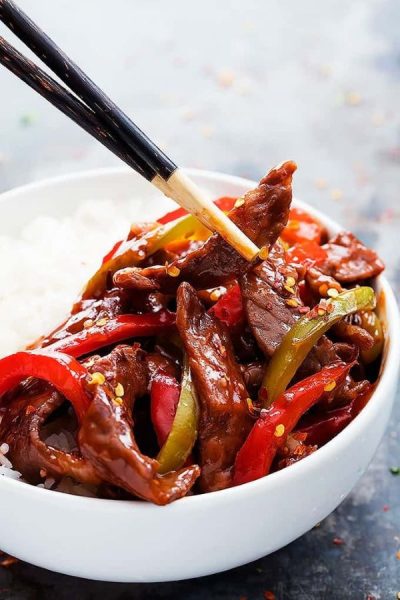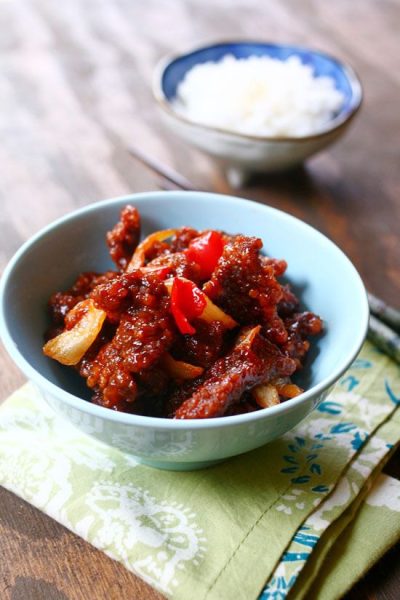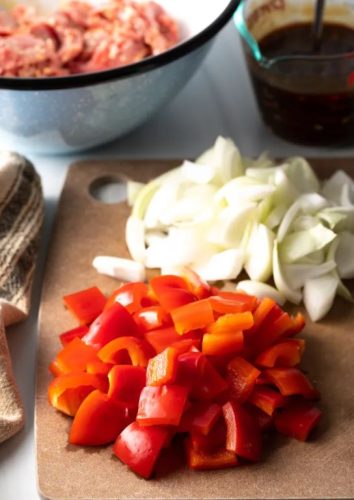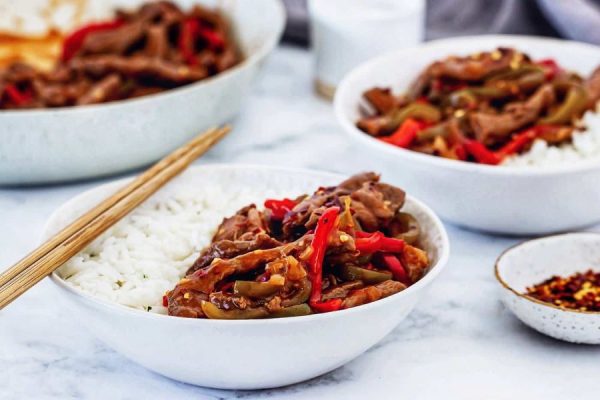Welcome to a delectable exploration into the heart of Chinese cuisine, where flavors dance on the palate and culinary traditions tell stories of centuries past. Today, we embark on a savory adventure centered around a dish that epitomizes the rich tapestry of Chinese flavors: Beijing Beef.
Beijing beef, a vibrant and flavorful dish originating from China’s capital city, is more than just a stir-fry. It’s a symphony of textures and tastes, a testament to the culinary ingenuity of the region.
This blog post is your one-stop guide to Beijing beef, delving into its history, exploring variations, and finally, equipping you with a delicious and easy-to-follow recipe to recreate this culinary masterpiece in your own home.
The origins of Beijing Beef can be traced back to the imperial kitchens of ancient China, where skilled chefs catered to the discerning tastes of emperors and nobility. Drawing inspiration from regional ingredients and culinary techniques, these culinary artisans crafted dishes that transcended mere sustenance, offering a symphony of flavors and textures.
Over the centuries, Beijing Beef evolved alongside China’s shifting cultural landscape, incorporating influences from various dynasties and culinary traditions. From the aromatic spices of the Silk Road to the delicate flavors of Cantonese cuisine, a unique dish emerged, blending diverse ingredients and cooking styles into a harmonious whole
The heart and soul of Beijing beef lies in its namesake sauce. This unique concoction, often referred to as “Tian Mian Jiang” , is a sweet and savory bean paste made from fermented soybeans, flour, and water. It forms the base of the sauce, offering a complex depth of flavor with hints of sweetness, umami, and a touch of funk.
Beyond the Tian Mian Jiang, other key ingredients in the sauce typically include:
These ingredients are combined and simmered, allowing the flavors to meld and mature, resulting in a robust sauce that coats the tender beef and vegetables perfectly.
Beyond its culinary prowess, Beijing Beef holds a special place in Chinese culture, serving as a symbol of prosperity, celebration, and community. Traditionally served during festive occasions and family gatherings, Beijing Beef embodies the spirit of togetherness and shared joy.
In modern times, Beijing Beef has transcended cultural boundaries, captivating the hearts and taste buds of food enthusiasts worldwide. Whether enjoyed in a bustling street market in Beijing or savored at a trendy restaurant in New York City, continues to inspire awe and delight, bridging the gap between cultures and bringing people together through the universal language of food.
While the core elements of Beijing beef remain constant, regional variations and personal preferences have led to the emergence of diverse interpretations of this beloved dish. Here are a few interesting variations to explore:
No matter your preference, there’s likely a variation out there waiting to be discovered and enjoyed.
To elevate your experience, consider pairing it with traditional accompaniments such as steamed rice or stir-fried vegetables. The subtle sweetness of jasmine rice complements the savory richness of the beef, while crisp, vibrant vegetables add a refreshing contrast to the dish.
For those seeking a bolder pairing, consider serving Beijing Beef alongside a glass of robust red wine or a refreshing lychee martini. The complex flavors of the wine or cocktail enhance the depth and complexity of the dish, creating a harmonious union of taste and texture.
As we bring our culinary journey to a close, we invite you to savor the flavors and embrace the traditions that make Beijing Beef a true culinary masterpiece. From its origins in the imperial kitchens of ancient China to its worldwide popularity, this dish embodies the spirit of innovation, tradition, and cultural exchange.
So the next time you find yourself craving a taste of the exotic, venture into the world of Beijing Beef and discover a culinary experience like no other. With each bite, you’ll uncover a symphony of flavors and a rich tapestry of tradition, inviting you to embark on a gastronomic adventure that transcends time and borders.
Come, join us on this savory journey, and experience the irresistible charm of culinary masterpiece for yourself.
[{"id":10941,"link":"https:\/\/kitchenguru.site\/one-pot-cajun-chicken-pasta-recipe-quick-flavorful-and-effortless\/","name":"one-pot-cajun-chicken-pasta-recipe-quick-flavorful-and-effortless","thumbnail":{"url":false,"alt":false},"title":"One Pot Cajun Chicken Pasta Recipe \u2013 Quick, Flavorful, and Effortless!","author":{"name":"arwynn","link":"https:\/\/kitchenguru.site\/author\/arwynn\/"},"date":"Nov 14, 2024","dateGMT":"2024-11-14 14:32:06","modifiedDate":"2024-11-14 14:32:06","modifiedDateGMT":"2024-11-14 14:32:06","commentCount":"0","commentStatus":"open","categories":{"coma":"<a href=\"https:\/\/kitchenguru.site\/category\/uncategorized\/\" rel=\"category tag\">Uncategorized<\/a>","space":"<a href=\"https:\/\/kitchenguru.site\/category\/uncategorized\/\" rel=\"category tag\">Uncategorized<\/a>"},"taxonomies":{"post_tag":""},"readTime":{"min":2,"sec":31},"status":"publish","excerpt":""},{"id":10910,"link":"https:\/\/kitchenguru.site\/how-to-make-the-best-smothered-pork-chops\/","name":"how-to-make-the-best-smothered-pork-chops","thumbnail":{"url":"https:\/\/kitchenguru.site\/wp-content\/uploads\/2024\/09\/pork2-e1726152946429.jpg","alt":"Smothered Pork Chops"},"title":"How to Make the Best Smothered Pork Chops","author":{"name":"arwynn","link":"https:\/\/kitchenguru.site\/author\/arwynn\/"},"date":"Sep 12, 2024","dateGMT":"2024-09-12 14:50:27","modifiedDate":"2024-09-17 19:38:21","modifiedDateGMT":"2024-09-17 19:38:21","commentCount":"0","commentStatus":"open","categories":{"coma":"<a href=\"https:\/\/kitchenguru.site\/category\/lunch-and-dinner-ideas\/\" rel=\"category tag\">lunch and dinner ideas<\/a>, <a href=\"https:\/\/kitchenguru.site\/category\/recipes\/\" rel=\"category tag\">Recipes<\/a>","space":"<a href=\"https:\/\/kitchenguru.site\/category\/lunch-and-dinner-ideas\/\" rel=\"category tag\">lunch and dinner ideas<\/a> <a href=\"https:\/\/kitchenguru.site\/category\/recipes\/\" rel=\"category tag\">Recipes<\/a>"},"taxonomies":{"post_tag":""},"readTime":{"min":6,"sec":0},"status":"publish","excerpt":""},{"id":10861,"link":"https:\/\/kitchenguru.site\/strawberry-cream-cheese-dip-for-every-occasion\/","name":"strawberry-cream-cheese-dip-for-every-occasion","thumbnail":{"url":"https:\/\/kitchenguru.site\/wp-content\/uploads\/2024\/08\/Screenshot-2024-08-15-172202-e1723735979687.jpg","alt":"strawberry cream cheese dip"},"title":"Strawberry Cream Cheese Dip: For Every Occasion","author":{"name":"arwynn","link":"https:\/\/kitchenguru.site\/author\/arwynn\/"},"date":"Aug 15, 2024","dateGMT":"2024-08-15 15:35:32","modifiedDate":"2024-08-15 16:45:48","modifiedDateGMT":"2024-08-15 16:45:48","commentCount":"0","commentStatus":"open","categories":{"coma":"<a href=\"https:\/\/kitchenguru.site\/category\/recipes\/\" rel=\"category tag\">Recipes<\/a>","space":"<a href=\"https:\/\/kitchenguru.site\/category\/recipes\/\" rel=\"category tag\">Recipes<\/a>"},"taxonomies":{"post_tag":"<a href='https:\/\/kitchenguru.site\/tag\/newest-dessert-ideas\/' rel='post_tag'>NEWEST DESSERT IDEAS<\/a><a href='https:\/\/kitchenguru.site\/tag\/popular-desserts\/' rel='post_tag'>POPULAR DESSERTS<\/a>"},"readTime":{"min":4,"sec":32},"status":"publish","excerpt":""},{"id":10806,"link":"https:\/\/kitchenguru.site\/is-risotto-gluten-free\/","name":"is-risotto-gluten-free","thumbnail":{"url":"https:\/\/kitchenguru.site\/wp-content\/uploads\/2024\/08\/3-2.jpg","alt":""},"title":"Is Risotto Gluten-Free? A Comprehensive Guide for Your Kitchen","author":{"name":"arwynn","link":"https:\/\/kitchenguru.site\/author\/arwynn\/"},"date":"Aug 10, 2024","dateGMT":"2024-08-10 07:32:56","modifiedDate":"2024-08-15 15:56:55","modifiedDateGMT":"2024-08-15 15:56:55","commentCount":"0","commentStatus":"open","categories":{"coma":"<a href=\"https:\/\/kitchenguru.site\/category\/lunch-and-dinner-ideas\/\" rel=\"category tag\">lunch and dinner ideas<\/a>, <a href=\"https:\/\/kitchenguru.site\/category\/recipes\/\" rel=\"category tag\">Recipes<\/a>","space":"<a href=\"https:\/\/kitchenguru.site\/category\/lunch-and-dinner-ideas\/\" rel=\"category tag\">lunch and dinner ideas<\/a> <a href=\"https:\/\/kitchenguru.site\/category\/recipes\/\" rel=\"category tag\">Recipes<\/a>"},"taxonomies":{"post_tag":"<a href='https:\/\/kitchenguru.site\/tag\/lunch-and-dinner-ideas\/' rel='post_tag'>lunch and dinner ideas<\/a>"},"readTime":{"min":5,"sec":32},"status":"publish","excerpt":""},{"id":10781,"link":"https:\/\/kitchenguru.site\/how-to-make-pork-osso-buco-at-home\/","name":"how-to-make-pork-osso-buco-at-home","thumbnail":{"url":"https:\/\/kitchenguru.site\/wp-content\/uploads\/2024\/08\/10.jpg","alt":"pork osso buco"},"title":"How to Make Pork Osso Buco at Home","author":{"name":"arwynn","link":"https:\/\/kitchenguru.site\/author\/arwynn\/"},"date":"Aug 9, 2024","dateGMT":"2024-08-09 23:33:29","modifiedDate":"2024-08-10 07:33:32","modifiedDateGMT":"2024-08-10 07:33:32","commentCount":"0","commentStatus":"open","categories":{"coma":"<a href=\"https:\/\/kitchenguru.site\/category\/lunch-and-dinner-ideas\/\" rel=\"category tag\">lunch and dinner ideas<\/a>, <a href=\"https:\/\/kitchenguru.site\/category\/recipes\/\" rel=\"category tag\">Recipes<\/a>","space":"<a href=\"https:\/\/kitchenguru.site\/category\/lunch-and-dinner-ideas\/\" rel=\"category tag\">lunch and dinner ideas<\/a> <a href=\"https:\/\/kitchenguru.site\/category\/recipes\/\" rel=\"category tag\">Recipes<\/a>"},"taxonomies":{"post_tag":"<a href='https:\/\/kitchenguru.site\/tag\/lunch-and-dinner-ideas\/' rel='post_tag'>lunch and dinner ideas<\/a>"},"readTime":{"min":2,"sec":42},"status":"publish","excerpt":""},{"id":10761,"link":"https:\/\/kitchenguru.site\/delightful-cod-mediterranean-recipe\/","name":"delightful-cod-mediterranean-recipe","thumbnail":{"url":"https:\/\/kitchenguru.site\/wp-content\/uploads\/2024\/08\/4-1.jpg","alt":"cod mediterranean recipe"},"title":"Delightful Cod Mediterranean Recipe","author":{"name":"arwynn","link":"https:\/\/kitchenguru.site\/author\/arwynn\/"},"date":"Aug 8, 2024","dateGMT":"2024-08-08 06:53:02","modifiedDate":"2024-08-10 12:27:51","modifiedDateGMT":"2024-08-10 12:27:51","commentCount":"0","commentStatus":"open","categories":{"coma":"<a href=\"https:\/\/kitchenguru.site\/category\/recipes\/\" rel=\"category tag\">Recipes<\/a>","space":"<a href=\"https:\/\/kitchenguru.site\/category\/recipes\/\" rel=\"category tag\">Recipes<\/a>"},"taxonomies":{"post_tag":"<a href='https:\/\/kitchenguru.site\/tag\/lunch-and-dinner-ideas\/' rel='post_tag'>lunch and dinner ideas<\/a>"},"readTime":{"min":2,"sec":4},"status":"publish","excerpt":""},{"id":10687,"link":"https:\/\/kitchenguru.site\/grilled-chicken-shawarma\/","name":"grilled-chicken-shawarma","thumbnail":{"url":"https:\/\/kitchenguru.site\/wp-content\/uploads\/2024\/08\/3d50754bb9843777b73030691f907285-e1722619801405.jpg","alt":"Grilled Chicken Shawarma"},"title":"Grilled Chicken Shawarma: A Flavorful Journey to the Middle East","author":{"name":"arwynn","link":"https:\/\/kitchenguru.site\/author\/arwynn\/"},"date":"Aug 2, 2024","dateGMT":"2024-08-02 16:17:38","modifiedDate":"2024-08-03 12:14:14","modifiedDateGMT":"2024-08-03 12:14:14","commentCount":"0","commentStatus":"open","categories":{"coma":"<a href=\"https:\/\/kitchenguru.site\/category\/lunch-and-dinner-ideas\/\" rel=\"category tag\">lunch and dinner ideas<\/a>, <a href=\"https:\/\/kitchenguru.site\/category\/recipes\/\" rel=\"category tag\">Recipes<\/a>","space":"<a href=\"https:\/\/kitchenguru.site\/category\/lunch-and-dinner-ideas\/\" rel=\"category tag\">lunch and dinner ideas<\/a> <a href=\"https:\/\/kitchenguru.site\/category\/recipes\/\" rel=\"category tag\">Recipes<\/a>"},"taxonomies":{"post_tag":"<a href='https:\/\/kitchenguru.site\/tag\/lunch-and-dinner-ideas\/' rel='post_tag'>lunch and dinner ideas<\/a>"},"readTime":{"min":4,"sec":9},"status":"publish","excerpt":""},{"id":10685,"link":"https:\/\/kitchenguru.site\/the-ultimate-bbq-chicken-wrap-a-flavor-packed-delight\/","name":"the-ultimate-bbq-chicken-wrap-a-flavor-packed-delight","thumbnail":{"url":"https:\/\/kitchenguru.site\/wp-content\/uploads\/2024\/08\/4-e1722581255860.jpg","alt":"bbq chicken wrap"},"title":"The Ultimate BBQ Chicken Wrap: A Flavor-Packed Delight","author":{"name":"arwynn","link":"https:\/\/kitchenguru.site\/author\/arwynn\/"},"date":"Aug 2, 2024","dateGMT":"2024-08-02 07:26:01","modifiedDate":"2024-08-03 12:14:49","modifiedDateGMT":"2024-08-03 12:14:49","commentCount":"0","commentStatus":"open","categories":{"coma":"<a href=\"https:\/\/kitchenguru.site\/category\/lunch-and-dinner-ideas\/\" rel=\"category tag\">lunch and dinner ideas<\/a>, <a href=\"https:\/\/kitchenguru.site\/category\/recipes\/\" rel=\"category tag\">Recipes<\/a>","space":"<a href=\"https:\/\/kitchenguru.site\/category\/lunch-and-dinner-ideas\/\" rel=\"category tag\">lunch and dinner ideas<\/a> <a href=\"https:\/\/kitchenguru.site\/category\/recipes\/\" rel=\"category tag\">Recipes<\/a>"},"taxonomies":{"post_tag":""},"readTime":{"min":4,"sec":12},"status":"publish","excerpt":""},{"id":10662,"link":"https:\/\/kitchenguru.site\/a-summer-twist-on-vegan-french-onion-soup\/","name":"a-summer-twist-on-vegan-french-onion-soup","thumbnail":{"url":"https:\/\/kitchenguru.site\/wp-content\/uploads\/2024\/07\/1-2-e1721932579463.jpg","alt":"Vegan French Onion Soup"},"title":"A Summer Twist on Vegan French Onion Soup","author":{"name":"arwynn","link":"https:\/\/kitchenguru.site\/author\/arwynn\/"},"date":"Jul 25, 2024","dateGMT":"2024-07-25 18:49:33","modifiedDate":"2024-07-25 19:30:03","modifiedDateGMT":"2024-07-25 19:30:03","commentCount":"0","commentStatus":"open","categories":{"coma":"<a href=\"https:\/\/kitchenguru.site\/category\/recipes\/\" rel=\"category tag\">Recipes<\/a>","space":"<a href=\"https:\/\/kitchenguru.site\/category\/recipes\/\" rel=\"category tag\">Recipes<\/a>"},"taxonomies":{"post_tag":""},"readTime":{"min":3,"sec":5},"status":"publish","excerpt":""},{"id":10621,"link":"https:\/\/kitchenguru.site\/the-perfect-lemon-pie-a-slice-of-sunshine\/","name":"the-perfect-lemon-pie-a-slice-of-sunshine","thumbnail":{"url":"https:\/\/kitchenguru.site\/wp-content\/uploads\/2024\/07\/1-1-e1721479869149.jpg","alt":"lemon pie"},"title":"The Perfect Lemon Pie: A Slice of Sunshine","author":{"name":"arwynn","link":"https:\/\/kitchenguru.site\/author\/arwynn\/"},"date":"Jul 20, 2024","dateGMT":"2024-07-20 09:48:11","modifiedDate":"2024-08-15 16:48:31","modifiedDateGMT":"2024-08-15 16:48:31","commentCount":"0","commentStatus":"open","categories":{"coma":"<a href=\"https:\/\/kitchenguru.site\/category\/cakes\/\" rel=\"category tag\">cakes<\/a>","space":"<a href=\"https:\/\/kitchenguru.site\/category\/cakes\/\" rel=\"category tag\">cakes<\/a>"},"taxonomies":{"post_tag":"<a href='https:\/\/kitchenguru.site\/tag\/popular-desserts\/' rel='post_tag'>POPULAR DESSERTS<\/a>"},"readTime":{"min":4,"sec":10},"status":"publish","excerpt":""},{"id":10548,"link":"https:\/\/kitchenguru.site\/hawaiian-bbq-chicken-a-taste-of-paradise\/","name":"hawaiian-bbq-chicken-a-taste-of-paradise","thumbnail":{"url":"https:\/\/kitchenguru.site\/wp-content\/uploads\/2024\/07\/hawaiian-bbq-chicken-2.jpg","alt":"hawaiian bbq chicken"},"title":"Hawaiian BBQ Chicken: A Taste of Paradise","author":{"name":"arwynn","link":"https:\/\/kitchenguru.site\/author\/arwynn\/"},"date":"Jul 17, 2024","dateGMT":"2024-07-17 17:48:55","modifiedDate":"2024-08-03 12:15:13","modifiedDateGMT":"2024-08-03 12:15:13","commentCount":"0","commentStatus":"open","categories":{"coma":"<a href=\"https:\/\/kitchenguru.site\/category\/lunch-and-dinner-ideas\/\" rel=\"category tag\">lunch and dinner ideas<\/a>, <a href=\"https:\/\/kitchenguru.site\/category\/recipes\/\" rel=\"category tag\">Recipes<\/a>","space":"<a href=\"https:\/\/kitchenguru.site\/category\/lunch-and-dinner-ideas\/\" rel=\"category tag\">lunch and dinner ideas<\/a> <a href=\"https:\/\/kitchenguru.site\/category\/recipes\/\" rel=\"category tag\">Recipes<\/a>"},"taxonomies":{"post_tag":"<a href='https:\/\/kitchenguru.site\/tag\/lunch-and-dinner-ideas\/' rel='post_tag'>lunch and dinner ideas<\/a><a href='https:\/\/kitchenguru.site\/tag\/popular-recipes\/' rel='post_tag'>POPULAR RECIPES<\/a>"},"readTime":{"min":3,"sec":0},"status":"publish","excerpt":""},{"id":10508,"link":"https:\/\/kitchenguru.site\/tiramisu-martini-recipe\/","name":"tiramisu-martini-recipe","thumbnail":{"url":"https:\/\/kitchenguru.site\/wp-content\/uploads\/2024\/07\/4.jpg","alt":""},"title":"Indulge in a Classic Italian Dessert - The Tiramisu Martini Recipe","author":{"name":"arwynn","link":"https:\/\/kitchenguru.site\/author\/arwynn\/"},"date":"Jul 2, 2024","dateGMT":"2024-07-02 17:46:47","modifiedDate":"2024-08-15 16:49:14","modifiedDateGMT":"2024-08-15 16:49:14","commentCount":"0","commentStatus":"open","categories":{"coma":"<a href=\"https:\/\/kitchenguru.site\/category\/recipes\/\" rel=\"category tag\">Recipes<\/a>","space":"<a href=\"https:\/\/kitchenguru.site\/category\/recipes\/\" rel=\"category tag\">Recipes<\/a>"},"taxonomies":{"post_tag":"<a href='https:\/\/kitchenguru.site\/tag\/popular-desserts\/' rel='post_tag'>POPULAR DESSERTS<\/a>"},"readTime":{"min":3,"sec":32},"status":"publish","excerpt":""}]














